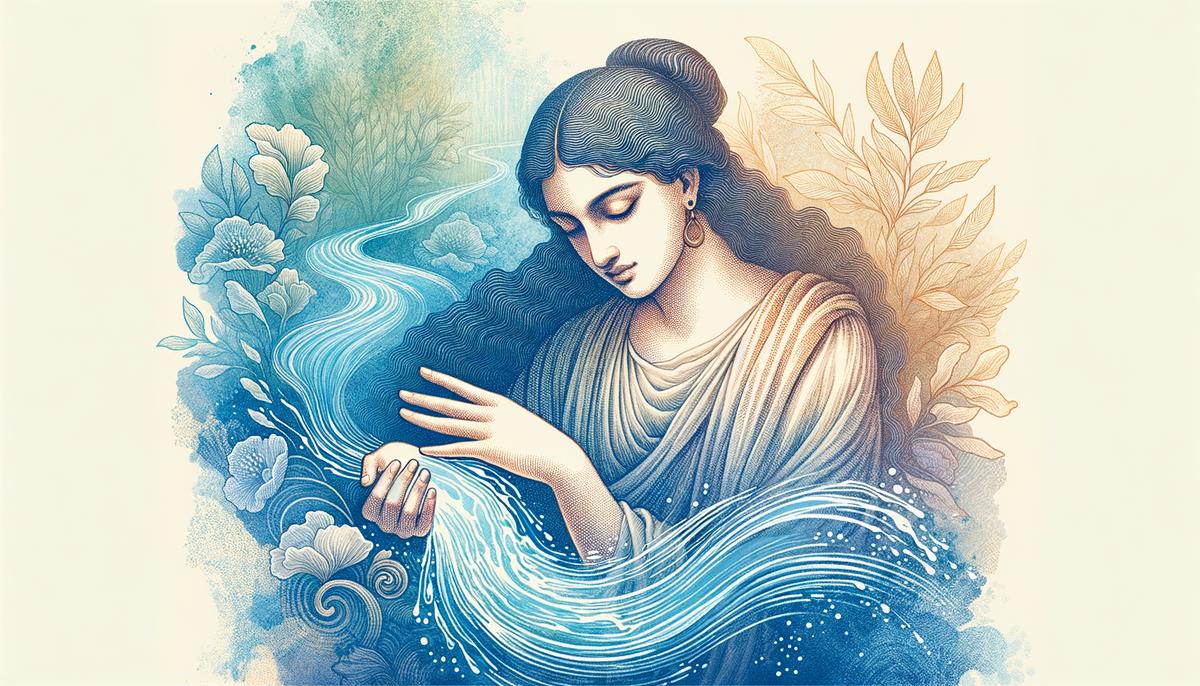Tethys' Origins and Family
Born as one of the twelve Titans, Tethys' parents—Uranus, the sky, and Gaia, the earth—set the stage for a lineage wielding vast aspects of the world. Such parents symbolized the foundational building blocks of existence in Greek cosmogony, making Tethys' descent a route directly traced to the elemental forces of the universe.
Partnering with her brother Oceanus, Tethys co-ruled the watery realms. This union brought forth rivers, seas, and 3000 Oceanids—each a deity linked to a water form. Here, literal and symbolic procreation mingles, rendering them the primordial source from which all freshwater on earth purportedly springs.
With siblings as varied as Cronus—the eventual leader who overthrows Uranus—and Rhea—the mother to eventual Olympians like Zeus—Tethys found herself amidst a plethora of divine narratives, each adding layers to her presence in myth. Figures such as the cyclops and Hecatonchires, terrifying in their might and directly related, add an aspect of formidable family dynamics where allegiance and power were ever-fluid.
The significance of Tethys within Greek mythology is therefore amplified by her relationships and lineage. As a maternal figure nurturing not just Greek gods but the very rivers and streams flowing across the earth's realms, her role goes beyond mythology into the embodiment of life-giving sustenance. Such connections between familial ties, power, and nurturing amplify Tethys's identity as a life-sustaining Titaness graced with the calm depths of freshwater—a cornerstone in a mythology filled with power plays and transformations.
Tethys' Role and Influence
Tethys, mother of the myriad streams and gentle naiads, casts a wide yet often understated net over the Greek mythological world. Her watery domain—sprightly brooks, serenity-laden lakes, and all cardinal rivers that ribbon through ancient tales—earned her a sacrosanct spot as the nurturer par excellence. It was the inherent moisture of her influence that rendered terrains fertile and birthed instances of lush abundance wherever an orb of fresh water settled.
Amidst all her gushing progeny, it is the Oceanids and the multitude of river gods, the Potamoi, that most distinctly underpin her tag as an elemental life-bringer. From the night-enshrouded bends of Nile to the hallowed banks of Styx, these deities were vital arteries of ancient landscape and spiritual conduits among their respective tribes and realms. Owning a kind of star-power, every Oceanid and river god who claimed descendancy from Tethys highlighted her authority and sustaining essence across the world's topographies.
Yet, Tethys's outpouring doesn't quench thirsts without weaving some divine drama. Consider her nurturing of Hera—Zeus's wife. It was Tethys who swaddled young Hera with tender, aquatic care, steeping the future goddess in elemental magics whispered by river stones and foam. This influence soon floated Hera towards her crucial roles and cosmic gripes which splayed across many an epic storyline involving Olympians.
Our maritime matron's essence ripples out further in the sprawling stellar vault as well. Engage with the constellation legend—the fate of Callisto and her ark in the skies, shimmering as Ursa Major. Here, Tethys plays a briny counterpart to celestial grudges; by forbidding Callisto, transformed into a bear then a constellation, from dipping below the horizon or touching her oceanic expanse, she insists on an astrological pettiness that surely spiced up divine dining chatter for epochs. This dictate inspired by Hera's divine annoyance with Zeus's dalliances illustrates Tethys's vast reach, controlling not just earthly freshness but also celestial mechanics.
With every rush of river and dewdrop filigree etching homeward paths in rosy mornings, Tethys's reign courses as a quiet yet constant pulse, nurturing creation and harboring tales in her pliant, watery embrace. She permeates myth and nature alike—a testament to how deities can forge principals mighty as oceans from elsewise whispered springs and secluded brooks.

Symbolism and Cultural Impact
Diving into symbolism, Tethys isn't just a footnote in Greek mythology; she represents the vast, life-giving sanctuary that is water. Ancient cultures universally revered water as the essence of life—a motif that the mythos of Tethys encapsulates perfectly. In her embraces with Oceanus, the duo become synonymous with origin stories everywhere: from where does life spring if not from the womb-like pools fed by Tethys' tender freshwater springs?
Tethys transcends the classical guise of a mere narrative wave to reflect on fertility and abundance. Given that nearly every civilization has credited its subsistence to the proximity and use of water bodies, Tethys' dominion over fresh waters transforms her into a deity resonating with fecundity and nurture—ethos practically flowing through cultures, participating fundamentally in their agricultural and societal expansions. Through these watery veins, she forms a mythological metaphor for the very cycle of life that both satiates the earth's thirst and leavens its entire breadth with a regenerative, nearly purifying might.
Advancing to modern reflections of her aquatic sovereignty, Tethys' name continues to ripple across distinct fields. Astronomy offers a nod to her hydrating legacy with Saturn's moon, Tethys—a celestial body discovered in 1684, encased in ice with a composition estimated to be nearly half water by mass.1 This satellite stands not only as a herald of her mythological terrain of moisture and continuity but also symbolizes an understanding that even out in the cold, vast reaches of space, the indispensable essence of life—as Tethys herself metaphorizes—prevails.
The echoes of her aquatic sovereignty splash over even into the terrestrial realm of geology through the Tethys Sea—an ancient ocean believed to have predated the modern layout of continental shifts. Stretching between the separating landmasses of Gondwana and Laurasia during the Mesozoic era, this massive body once connected most Earth's current seas.2 In geological terms, it paints an earthly version of Tethys' generative swath across civilizations—a creator of landscapes and pathways for life wanderers, flanked by freshwater and primordial allure.
In navigating these telluric and astrological mappings back to mythology, one grasps a sustained reach placing Tethys not just among the starry constellations or beneath earthy strata but elevating her into an archetype gracing ideological shores. It's less about whether cultures recognized her divinity explicitly; the symbolism itself of sustaining fresh waters underpins the vital essence across mythologies and manifests abundantly in natural philosophy.
That Tethys could so fluidly drift into various modes—from nurturing mythological waters with potently fertile streams in literature, snaking through ethereal voids embossed by celestial bodies, to coursing under tectonic plates—solidifies a continuum reflecting her cultural jet streams even millennia past their bridal currents in ancient Greek lore. Thus, in waters both cosmic and earthly, Tethys continues her serene rule—a muted, yet ubiquitous matriarchal resonance cradling life in bountiful depths.
Comparative Mythology: Tethys and Other Water Deities
Navigating the flowing currents of comparative mythology, Tethys often seems like but a mysterious eddy next to the oceanic might of other aqueous deities. Her tranquil waters may murmur softly alongside the roaring waves of Oceanus and Poseidon, or ripple quietly near the stormy depths of Babylonian Tiamat, but each deity holds their own in the diverse pantheon of water wonders.
Oceanus epitomizes the literal oceans—a ring of water encircling the flat Earth, according to Greek cosmology. Unlike Tethys, whose freshwaters feed and nourish, Oceanus covers a broader, saltier spectrum. They also serve as a comprehensive representation of all outer waters, balancing perceptions between creation forces and destructive capabilities. Standing beside her consort, Tethys contrasts significantly, her narrower domain is no less essential; where he ebbs and flows in eternity, she replenishes and sustains.
In the realm of tumults and tempest, Poseidon rules. Often envisioned towering with a trident, he governs earthquakes and horses but is most famous as the tempestuous god of the sea. Differing from Tethys's tranquil nurturing ponds, Poseidon's domains are fierce, as tumultuous as the worst sea storms, reflecting raw power rather than her gentle caretaking of the essential living waters. Although they might attire from a similar aqueous closet, their faces shown to the world—serene sustenance versus mighty conquest—are distinct to behold.
Stepping into the ancient near-Eastern waters, Tiamat of Babylonian mythology redefines elemental power. This sea goddess embodies the saltwater oceans and conveys chaos-incarnate through her mythos. Unlike Tethys, whose nurturances channel growth and life facilitation, Tiamat leads invocations of combating creation itself, birthing monsters in retaliatory wrath against her younger divine progeny. It brings to discussion how cultural ideals shape water into life-giving sylphs or agents of chaos—a fine contrast to Tethys's supportive yet passive role.
These differences and similarities in roles reflect not only ecological or biological significance but also deeper cultural and symbolic perceptions of water in society. Where Greeks considered freshwater an essence of nurture due to their reliance on agriculture and sustenance from rivers and streams, Mesopotamians, dwelling often in harsher terrains, encountered the sea's treachery as a daily menace affiliated with chaos exemplified by Tiamat.
Despite their diversity, one prevailing continuity unknots within their tales—water deities operate not only as natural descriptors but as profound metaphorical vessels. They ebb and flood through psychic territories, carrying along sub-surface values about creation, destruction, life, and death.
Sitting by any body of water provides a touchstone—a ledger of reflective contemplations linking every culture back to these mighty beings. Tethys, a quieter presence among them, guards her niche within universal dialogues just as flowing as Poseidon's fierce surf or Tiamat's stormy historical waves. Thus, in the mirrored waters of myth and reality, these deities extend their stories beneath their surface calm or storied tempests—forever pooling under starlit skies than any marquees of divine constellations who called them forth across worlds' edges.

- Thomas PJ, Hershey JR, Moore JM, et al. The geology of Saturn's satellite Tethys: implications from Cassini ISS observations. Icarus. 2007;190(2):348-358.
- Stampfli GM, Borel GD. A plate tectonic model for the Paleozoic and Mesozoic constrained by dynamic plate boundaries and restored synthetic oceanic isochrons. Earth Planet Sci Lett. 2002;196(1-2):17-33.

Leave a Reply